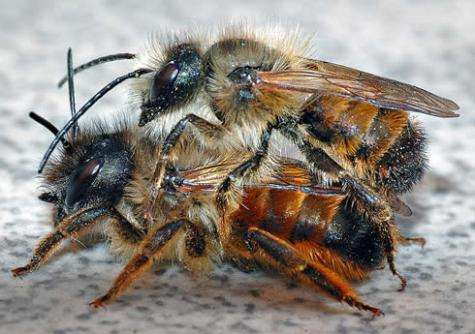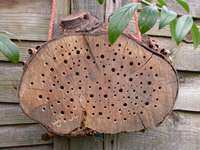Swarm-like behavior of red mason solitary bees

Have you seen what looks like a bee swarm in your garden recently? Well, if you think you have, it is more likely to be a gathering of harmless red mason bees than a swarm of aggressive bees.
Red mason bees, Osmia rufa, are one of many species of bee that are known as solitary bees because they live alone and make individual nests.
However, females search for mud to build their nests in areas of disturbed soil, and so many can be attracted to the same spot, creating a swarm-like appearance.
This gathering of solitary bees is called aggregating. Red mason bees also aggregate when they nest, often sharing an entrance to a good site, but having their own individual brood cells inside where they lay their eggs.
Favorite nesting spots for red mason bees are up high in small gaps and holes in bricks and buildings, which is where the 'mason' in their name comes from.

Insect expert Stuart Hine at the Natural History Museum Identification and Advisory Service gets a few enquiries each year from people worried that they have a swarm of aggressive bees developing in their garden or at the side of their house.
He explains the bees' nesting behavior. "The female makes a series of cells with soft soil and packs each cell with a paste made of pollen and nectar, which will feed and nourish the single larvae in each cell."
"Each female provisions her own cells, hence the solitary nature of these bees, though they often nest in aggregations giving the impression of a colony - but this is more to do with strength in numbers than true sociality."
"They can sometimes construct nests in peculiar places, including door locks and folds in curtains."
It's not only honeybees and bumblebees that are important for pollinating fruits and commercial crops like cucumbers and coffee. Solitary bees carry out this crucial role too.
In fact, red mason bees are important pollinators of apple trees. Orchard owners can order pre-populated nesting tubes of red mason bees to make sure there are enough of them to carry out this valuable service.
You can encourage solitary bees into your garden by making nesting tubes out of bamboo stems, cardboard tubing or holes drilled into old wood. Or buy ready-made 'bee hotels'. They should be placed about 1-2 metres above the ground in a south facing direction.
The red mason bee has reddish-brown hair. Both sexes are similar in appearance though females have small 'horns' on their face and males are smaller, lack horns and have noticeably longer antennae. They are widespread in the UK and appear as soon as fruit trees start flowering.
Stuart adds, "Look out too for the blue mason bees. They are similar in general appearance though slightly smaller and with a noticeable metallic blue sheen."
You can get help identifying the more than 250 species of solitary bee in the UK, from Stuart and other insect experts, by posting your photos to the Museum's NaturePlus identification forum.
Red mason bees only live for about 6 weeks. The females spend most of their time making and provisioning their nests.
Once they’ve laid their eggs, the adults die, the larvae hatch, and then in April and May of the following year in the UK, the fully formed adult bee emerges.
Provided by American Museum of Natural History


















